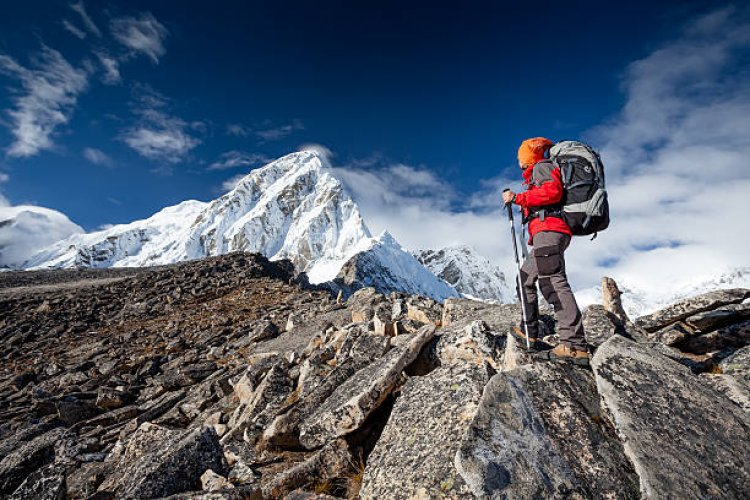Trekking in the Himalayas: A Journey Through Beauty and Adventure
Embark on the journey of a lifetime with our guide to trekking in the Himalayas. Explore the stunning natural beauty of the world's tallest mountain range and experience the adventure of a lifetime.

The Himalayas, the tallest mountain range in the world, offer some of the most breathtaking trekking routes in the world. With its towering peaks, rolling hills, deep valleys, and rich cultural heritage, trekking in the Himalayas is a journey that combines natural beauty with adventure. Whether you're an experienced trekker or a first-timer, the Himalayas offer something for everyone.
Introduction to Trekking in the Himalayas
The Himalayas are home to eight of the ten tallest peaks in the world, including Mount Everest, the tallest of them all. Trekking in the Himalayas provides an opportunity to experience the region's stunning landscapes, unique culture, and rich biodiversity. The trekking routes in the Himalayas range from easy to challenging, so there's something for everyone, regardless of their fitness level.
Planning Your Trek
Before embarking on your trek, it's important to plan ahead and make the necessary preparations.
Choosing the Right Trekking Route:
There are a variety of trekking routes in the Himalayas, ranging from easy to challenging. You should choose a route that matches your fitness level and experience. Some of the most popular trekking routes include the Annapurna Circuit, the Everest Base Camp Trek, and the Langtang Valley Trek.
Preparing for the Trek:
Physical preparation is crucial for a successful trek in the Himalayas. You should start training several months before your trek, focusing on building up your endurance and strengthening your legs and core. You should also research the type of gear you will need for the trek and make sure you have everything you need before you leave.
Obtaining Necessary Permits and Visas:
Depending on the trekking route you choose, you may need to obtain permits and visas. Make sure to research the requirements for your specific route and obtain the necessary documents in advance.
Finding a Reliable Trekking Company or Guide:
Hiring a reputable trekking company or guide can help ensure a safe and successful trek. Make sure to research different trekking companies and guides, and choose one that has a good reputation and offers high-quality services.
The Trekking Experience
The trekking experience in the Himalayas is a journey that combines natural beauty and adventure. The region offers a range of trekking experiences, from easy hikes to challenging climbs up towering peaks. Along the way, trekkers are treated to breathtaking views of glaciers, valleys, and snow-capped mountains, and the chance to experience the region's rich cultural heritage.
The trek itself is physically demanding and requires proper planning and preparation. This includes choosing the right trekking route, hiring a knowledgeable guide, and ensuring you have the proper gear and equipment. It's also important to be aware of the unique health and safety considerations of trekking in the Himalayas, such as altitude sickness and natural hazards.
Another important aspect of the trekking experience in the Himalayas is environmental sustainability. The region is facing a range of environmental challenges, and trekkers can play an important role in helping to protect the environment by practicing responsible trekking practices. This includes proper waste disposal, reducing your carbon footprint, and supporting conservation efforts.
Overall, the trekking experience in the Himalayas is a once-in-a-lifetime opportunity to experience the natural beauty of one of the world's most stunning regions. With proper planning, responsible trekking practices, and an appreciation for the challenges and rewards of trekking in the Himalayas, your journey is sure to be a memorable one.
Health and Safety Considerations
Trekking in the Himalayas can be physically and mentally demanding, so it's important to be aware of the health and safety considerations.
Managing Altitude Sickness:
Altitude sickness is a common concern for trekkers in the Himalayas. It occurs when your body is unable to acclimate to the high altitude. Symptoms include headache, fatigue, and shortness of breath. To minimize your risk of altitude sickness, make sure to drink plenty of water, eat well, and avoid overexerting yourself.
Dealing with Natural Hazards:
The Himalayas are prone to natural hazards such as landslides, avalanches, and flash floods. It's important to be aware of these hazards and follow the advice of your guide to minimize your risk.
Staying Safe from Wildlife: The Himalayas are home to a variety of wildlife, including Himalayan bears, snow leopards, and blue sheep. While these animals are generally shy and unlikely to attack, it's still important to take precautions and follow the advice of your guide to stay safe.
Importance of Adequate Insurance Coverage:
Trekking in the Himalayas can be physically demanding, and it's important to have adequate insurance coverage in case of injury or illness. Make sure to research the insurance options available and choose one that provides the coverage you need.
Environmental Sustainability
Environmental sustainability refers to the responsible use and management of natural resources so that future generations can continue to enjoy the benefits they provide. In the context of trekking in the Himalayas, environmental sustainability is about minimizing the negative impact of tourism on the region and its unique ecosystems, while also supporting the livelihoods of local people.
The Himalayas are facing a range of environmental challenges, including climate change, deforestation, and overgrazing. These challenges are affecting the region's unique landscapes and wildlife, and posing a threat to the livelihoods of local people.
As a trekker, you can play an important role in helping to protect the region and its people by practicing responsible trekking. This includes:
-
Proper waste disposal:
This means properly disposing of your waste and litter, and avoiding practices that harm the environment, such as littering or leaving food scraps. -
Reducing your carbon footprint:
This means reducing the amount of greenhouse gas emissions you produce, such as by using public transportation or offsetting your emissions through carbon credits. -
Supporting conservation efforts:
This means choosing trekking companies and guides that are committed to environmental sustainability, and supporting conservation efforts in the region.
By being mindful of your impact on the region and supporting conservation efforts, trekkers can help protect the Himalayas and its people for generations to come.
In conclusion, trekking in the Himalayas is a journey that combines natural beauty with adventure. From its towering peaks to its rich cultural heritage, the region offers something for everyone. Whether you're an experienced trekker or a first-timer, the Himalayas offer a truly unforgettable experience. With proper planning, responsible trekking practices, and an appreciation for the region's unique challenges and rewards, your journey through the Himalayas is sure to be a memorable one.
What's Your Reaction?





































































































